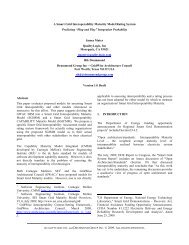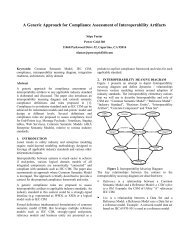Towards Interoperability Standards in Indian Power Sector ...
Towards Interoperability Standards in Indian Power Sector ...
Towards Interoperability Standards in Indian Power Sector ...
Create successful ePaper yourself
Turn your PDF publications into a flip-book with our unique Google optimized e-Paper software.
<strong>in</strong>struments <strong>in</strong> substations and transmitted by remote<br />
term<strong>in</strong>al unit (RTU) dur<strong>in</strong>g the event, and thus is referred as<br />
"real-time" data. The direction of operational is bottom-up<br />
flow<strong>in</strong>g to higher levels of hierarchy, while be<strong>in</strong>g collected,<br />
aggregated and summarised at each level. The operational<br />
data flow network is shown <strong>in</strong> Fig. 5.<br />
5.3. Control data flow<br />
The data that is exchanged as control commands from<br />
control centres is def<strong>in</strong>ed as control data. The network of<br />
control data flow is exactly same as that of operational data<br />
flow except that the direction of data flow is reversed.<br />
However, it is important to note that the same physical<br />
network is typically not used for exchange of control data.<br />
Follow<strong>in</strong>g the decisions made <strong>in</strong> the control centres the<br />
control commands are despatched on phone communication<br />
by the operators with the agency who is responsible for<br />
carry<strong>in</strong>g out the commands. Thus there is a human<br />
<strong>in</strong>tervention <strong>in</strong> delivery of control operations of the system,<br />
which is a hurdle <strong>in</strong> implementation of closed loop<br />
automated control. At distribution system level there are<br />
some utilities equipped with capabilities of remote operation<br />
of the switches and circuit breakers.<br />
5.4. Commercial data flow<br />
The data that is exchanged after the event of transfer of<br />
electrical energy so as to calculate and dissem<strong>in</strong>ate the<br />
<strong>in</strong>formation on commercial settlements to all the<br />
participants of the power network is def<strong>in</strong>ed as commercial<br />
data. The commercial settlement is usually carried out after<br />
the day of actual event, referred as (D+1) or later. The<br />
commercial data flow network is shown <strong>in</strong> Fig. 6.<br />
It is seen that at the organisation level, the roles and<br />
responsibilities are well def<strong>in</strong>ed among various k<strong>in</strong>ds of<br />
<strong>Indian</strong> utilities [10]. This creates a hierarchical network of<br />
utilities <strong>in</strong>volved <strong>in</strong> operat<strong>in</strong>g the power network by<br />
communicat<strong>in</strong>g over the <strong>in</strong>formation network. Every l<strong>in</strong>k <strong>in</strong><br />
the communication is backed up with a specific bus<strong>in</strong>ess<br />
context as to why such a communication is needed.<br />
Follow<strong>in</strong>g the restructur<strong>in</strong>g of the power sector and under<br />
the active contributions from the regulatory agencies at all<br />
levels, the public and private utilities are evolv<strong>in</strong>g <strong>in</strong> a<br />
dynamic environment. Based on the data flow network <strong>in</strong><br />
the above figures, it can be generalized that the the<br />
<strong>in</strong>formation flow is typically assum<strong>in</strong>g a radial tree like<br />
structure.<br />
6. STANDARDIZATION ACTIVITIES<br />
Under the Bureau of <strong>Indian</strong> <strong>Standards</strong>, currently six<br />
different work<strong>in</strong>g groups are constituted on <strong>Interoperability</strong>,<br />
Security, Common Information Model, Phasor<br />
Measurement Units, Distribution Management System,<br />
Digital Architecture Framework, respectively. The different<br />
work<strong>in</strong>g groups were each assigned a convenor and a<br />
secretary and essentially the Work<strong>in</strong>g Groups were given<br />
free re<strong>in</strong> to create a Terms Of Reference (ToR) document<br />
and then work towards the completion of the objectives<br />
stated <strong>in</strong> the ToR. The WGs were also tasked to form their<br />
members from the list of participants <strong>in</strong> the <strong>in</strong>itial steer<strong>in</strong>g<br />
meet<strong>in</strong>g of the LITD10 subcommittee where the WGs were<br />
formed and also requested to <strong>in</strong>duct other members as<br />
required to meet their requirements. The WG1 formed a<br />
ToR [3] with objectives as described <strong>in</strong> section 1.2 and<br />
<strong>in</strong>ducted members from Utilities (3 organizations), major IT<br />
companies(4 organizations), Government Research<br />
Institutions (1), orig<strong>in</strong>al equipment manufacturers <strong>in</strong> the<br />
power sector (5 organizations) and Academics Institutions<br />
(1). The WG1 scheduled and conducted several meet<strong>in</strong>gs<br />
which resulted <strong>in</strong> the formation of sub-groups for IT,OT and<br />
CT and the creation of the context-mapp<strong>in</strong>g document. The<br />
WG1 is currently work<strong>in</strong>g on a comprehensive<br />
questionnaire that covers the important aspects of IT, OT<br />
and CT use with<strong>in</strong> Utilities aimed at extract<strong>in</strong>g the as-is<br />
state of the work<strong>in</strong>gs of these technologies. The WG aims to<br />
deliberate on the f<strong>in</strong>d<strong>in</strong>gs from the questionnaire and move<br />
on to form<strong>in</strong>g recommendations which will ultimately result<br />
<strong>in</strong> the creation of the <strong>Interoperability</strong> <strong>Standards</strong><br />
7. CONCLUSION<br />
The current scenario of growth <strong>in</strong> <strong>Indian</strong> power sector is<br />
briefly outl<strong>in</strong>ed, highlight<strong>in</strong>g the need for <strong>Interoperability</strong><br />
standardization at various levels through out the sector. This<br />
paper identifies the importance of establish<strong>in</strong>g a solid<br />
<strong>in</strong>teroperability foundation and outl<strong>in</strong>es a contextual<br />
framework among all the participat<strong>in</strong>g organizations to coord<strong>in</strong>ate,<br />
communicate, collaborate and contribute <strong>in</strong><br />
address<strong>in</strong>g the <strong>in</strong>teroperability issues <strong>in</strong> <strong>Indian</strong> power sector.<br />
As a new wave of <strong>in</strong>vestments are already underway <strong>in</strong><br />
expansion of the sector at all levels, it is imperative that the<br />
<strong>in</strong>teroperability standards are established and adhered for<br />
deriv<strong>in</strong>g long term returns from these <strong>in</strong>vestments.<br />
References<br />
1. Y. Pradeep, S. A. Khaparde, and Reji Kumar, "Intelligent<br />
Grid Initiatives <strong>in</strong> India", 14th IEEE International<br />
Conference on Intelligent System Applications to <strong>Power</strong><br />
Systems (ISAP), Kaoshiung, Taiwan, Nov 4th - 9th, 2007.<br />
2. Sukh Bir S<strong>in</strong>gh, National and International IT<br />
standardization, Onl<strong>in</strong>e: http://www.bis.org.<strong>in</strong>/other/Mr.<br />
%20Sukh%20Bir%20S<strong>in</strong>gh,%20BIS.ppt<br />
3. Terms of Reference Document of work<strong>in</strong>g group on<br />
<strong>Interoperability</strong> (WG1)<br />
4. Open Knowledge Initiative, 2010, Onl<strong>in</strong>e:<br />
http://www.okiproject.org/view/html/site/oki/node/2916<br />
5. The M<strong>in</strong>istry of <strong>Power</strong> [Onl<strong>in</strong>e]. Available:<br />
http://www.powerm<strong>in</strong>.nic.<strong>in</strong>/<strong>in</strong>dian_electricity_scenario/pow<br />
er_for_all_target.htm<br />
Grid-Interop Forum 2010







